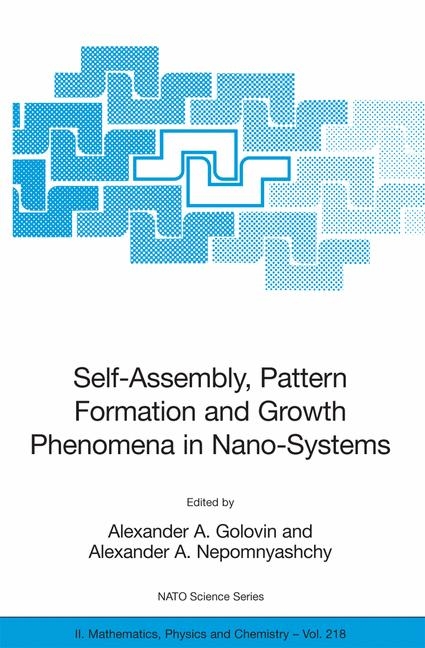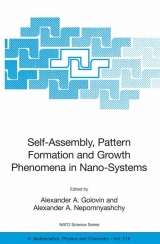Self-Assembly, Pattern Formation and Growth Phenomena in Nano-Systems
Springer-Verlag New York Inc.
978-1-4020-4354-3 (ISBN)
- Titel ist leider vergriffen;
keine Neuauflage - Artikel merken
Nano-science and nano-technology are rapidly developing scientific and technological areas that deal with physical, chemical and biological processes that occur on nano-meter scale - one millionth of a millimeter. Self-organization and pattern formation play crucial role on nano-scales and promise new, effective routes to control various nano-scales processes. This book contains lecture notes written by the lecturers of the NATO Advanced Study Institute "Self-Assembly, Pattern Formation and Growth Phenomena in Nano-Systems" that took place in St Etienne de Tinee, France, in the fall 2004. They give examples of self-organization phenomena on micro- and nano-scale as well as examples of the interplay between phenomena on nano- and macro-scales leading to complex behavior in various physical, chemical and biological systems.
They discuss such fascinating nano-scale self-organization phenomena as self-assembly of quantum dots in thin solid films, pattern formation in liquid crystals caused by light, self-organization of micro-tubules and molecular motors, as well as basic physical and chemical phenomena that lead to self-assembly of the most important molecule on the basis of which most of living organisms are built - DNA. A review of general features of all pattern forming systems is also given. The authors of these lecture notes are the leading experts in the field of self-organization, pattern formation and nonlinear dynamics in non-equilibrium, complex systems.
Dedication. Contributing Authors. Foreword. Preface. Acknowledgements. General aspects of pattern formation; A.A. Nepomnyashchy, A.A. Golovin. 1. Introduction. 2. Basic models for domain coarsening and pattern formation. 3. Pattern selection. 4. Modulated patterns. 5. Beyond the Swift-Hohenberg model. 6. Wavy patterns. 7. Conclusions. 8. Acknowledgement. References.- Convective patterns in liquid crystals driven by electric field; A. Buka et al. 1. Physical properties of nematics. 2. Electroconvection. References.- Dynamical phenomena in nematic liquid crystals induced by light; D.O. Krimer et al. 1. Simple setups - complicated phenomena. 2. Theoretical description. 3. Obliquely incident, linearly polarized light. 4. Perpendicularly incident, circularly polarized light. 5. Perpendicularly incident, elliptically polarized light. 6. Finite beam-size effects and transversal pattern formation. Acknowledgements. References.- Self-Assembly of quantum dots from thin solid films; A.A. Golovin et al. 1. Introduction. 2. Mechanisms of morphological evolution of epitaxial films. 3. Elastic effects and wetting interactions. 4. Surface-energy anisotropy and wetting interactions. 5. Conclusions. References.- Macroscopic and mesophysics together: the moving contact line problem revisited; Y. Pomeau. References.- Nanoscale effects in mesoscopic films; L.M. Pismen. 1. Hydrodynamic equations. 2. Thermodynamic equations. 3. Fluid-substrate Interactions. 4. Dynamic contact line. 5. Mobility relations. References.- Dynamics of thermal polymerization waves; V.A. Volpert. 1. Introduction. 2. Mathematical model. 3. Gasless combustion. 4. Analysis of base FP model. 5. Other thermal FP studies. 6. Conclusion. References.- Self-organization of microtubules and motors; I.S. Aranson, L.S. Tsimring. 1. Maxwell model and orientational instability. 2. Spatial localization. 3. Aster and vortex solutions. 4. Conclusion. Acknowledgements. References.- Physics of DNA; M.D. Frank-Kamenetskii. 1. Introduction. 2. Major structures of DNA. 3. DNA functioning. 4. Global DNA conformation. 5. The DNA stability. 6. Conclusion. References. Topic index.
| Erscheint lt. Verlag | 21.12.2005 |
|---|---|
| Reihe/Serie | NATO Science Series II: Mathematics, Physics and Chemistry ; 218 |
| Zusatzinfo | biography |
| Verlagsort | New York, NY |
| Sprache | englisch |
| Maße | 155 x 235 mm |
| Gewicht | 669 g |
| Themenwelt | Naturwissenschaften ► Physik / Astronomie ► Astronomie / Astrophysik |
| Naturwissenschaften ► Physik / Astronomie ► Theoretische Physik | |
| Technik | |
| ISBN-10 | 1-4020-4354-6 / 1402043546 |
| ISBN-13 | 978-1-4020-4354-3 / 9781402043543 |
| Zustand | Neuware |
| Haben Sie eine Frage zum Produkt? |
aus dem Bereich




